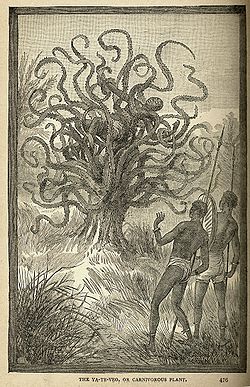- Man-eating tree
-
Man-eating tree can refer to any of various legendary or cryptid carnivorous plants that are large enough to kill and consume a person or other large animal.[1] In actuality, the carnivorous plant with the largest known traps is probably Nepenthes rajah, which produces pitchers up to 38 cm (15 in) tall with a volume of up to 3.5 litres (0.77 imp gal; 0.92 US gal).[2] This species may rarely trap small mammals.[3]
Contents
The Madagascar tree
The earliest well known report of a man-eating tree originated as a hoax. In 1881 German explorer "Carl Liche" wrote an account in the South Australian Register of encountering a sacrifice performed by the "Mkodo" tribe of Madagascar:[4]
"The slender delicate palpi, with the fury of starved serpents, quivered a moment over her head, then as if instinct with demoniac intelligence fastened upon her in sudden coils round and round her neck and arms; then while her awful screams and yet more awful laughter rose wildly to be instantly strangled down again into a gurgling moan, the tendrils one after another, like great green serpents, with brutal energy and infernal rapidity, rose, retracted themselves, and wrapped her about in fold after fold, ever tightening with cruel swiftness and savage tenacity of anacondas fastening upon their prey."[5]
The tree was given further publicity by the 1924 book by former Governor of Michigan Chase Osborn, Madagascar, Land of the Man-eating Tree.[6] Osborn claimed that both the tribes and missionaries on Madagascar knew about the hideous tree, and also repeated the above Liche account.
In his 1955 book, Salamanders and other Wonders,[7] science author Willy Ley determined that the Mkodo tribe, Carl Liche, and the Madagascar man-eating tree itself all appeared to be fabrications.
The Ya-te-veo
In J. W. Buel's Land and Sea (1887), the Ya-te-veo ("Now-I-see-you") plant is said to catch and consume large insects, but also attempts to consume humans.
It is said to be a carnivorous plant that grows in parts of Central and South America with cousins in Africa and on the shores of the Indian Ocean.[citation needed]
There are many different descriptions of the plant, but most reports say it has a short, thick trunk and long tendrils of some sort which are used to catch prey.
Literature
Man-eating plants have appeared in literature.
- In the Harry Potter series a plant called Devil's Snare attempts to eat Harry and his friends by entangling them with its vines, when they try to find the Philospher's stone; it also strangles a hospital patient in Harry Potter and the Order of the Phoenix.
- In "The Sagebrush Kid", a short story in Annie Proulx's 2008 Fine Just the Way It Is, a childless Wyoming couple transfer their affections first to a piglet, then a chicken, and finally to a sagebrush they fancy to have the appearance of a child.[8] It is tended and protected, and even fed bones and stray scraps of meat from their dinner-table. Even after the couples' passing, the shrub - now grown to the height of a fair-sized tree - is used to human attention, and meat. It consumes livestock, then soldiers, then a local medico, railroad men, surveyors, and most lately a botanist come to investigate its unusual height and luxuriance.[9]
- In Beyond the Deepwoods, the first story in Paul Stewart and Chris Riddell's The Edge Chronicles, the protagonist Twig encounters a man-eating tree called a Bloodoak. A parasitic symbiotic plant know as the tarryvine snares victims and then drags them to the Bloodoak where they are devoured.
See also
References
- ^ Shuker, Karl (2003). The Beasts That Hide From Man. Paraview. ISBN 1-931044-64-3.
- ^ McPherson, S.R. 2009. Pitcher Plants of the Old World. Redfern Natural History Productions Ltd., Poole.
- ^ Phillipps, A. 1988. A second record of rats as prey in Nepenthes rajah.PDF (203 KiB) Carnivorous Plant Newsletter 17(2): 55.
- ^ Ron Sullivan and Joe Eaton (October 27, 2007). "The Dirt: Myths about man-eating plants - something to chew on". San Francisco Chronicle. http://www.sfgate.com/cgi-bin/article.cgi?f=/c/a/2007/10/27/HOIASVF6T.DTL. Retrieved 2007-10-26.
- ^ Tyson, Peter. "A Forest Full of Frights, part 2". The Wilds of Madagascar. Nova Online. http://www.pbs.org/wgbh/nova/madagascar/surviving/frights2.html.
- ^ Osborn, Chase Salmon (1925). Madagascar, Land of the Man-eating Tree.
- ^ Ley, Willy (1955). Salamanders and other Wonders. Viking Press.
- ^ Maunder, Patricia (21 January 2009). "Fine Just the Way It Is: Annie Proulx (review)". Australian Broadcasting Corporation. http://www.abc.net.au/rn/bookshow/stories/2009/2452573.htm#TRANSCRIPT. Retrieved 18 March 2010.
- ^ Ron Carlson (7 September 2008). "True Grit". New York Times. http://www.nytimes.com/2008/09/07/books/review/Carlson-t.html. Retrieved 18 March 2010.
Other sources
- Michell, John and Rickard, Bob (2000). The Rough Guide to Unexplained Phenomena. Rough Guides. ISBN 1-85828-589-5.
Categories:- Folklore
- Mythical plants
- Cryptids
Wikimedia Foundation. 2010.

